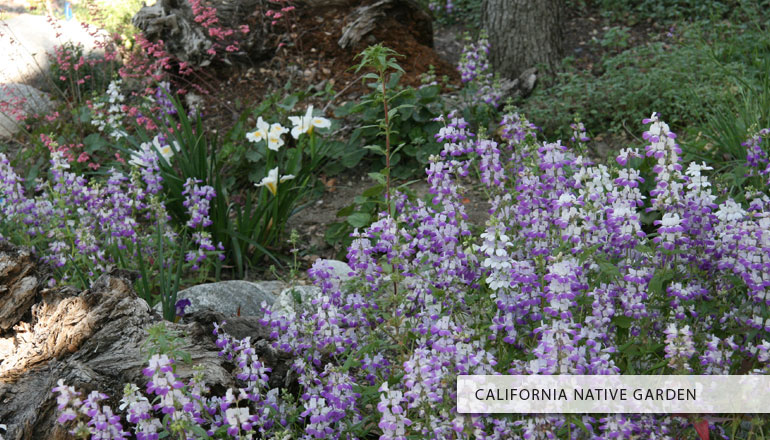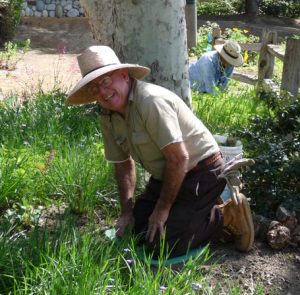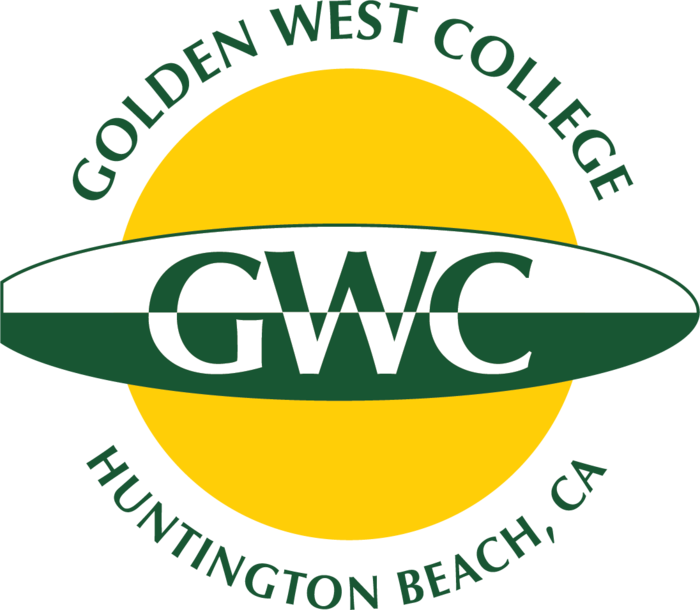Did You Know?
California Native Garden
2/4/11
The GWC Native Garden has an active volunteer group?
Meeting most Tuesday and Thursday mornings, our Garden volunteers have worked over 920 hours in the last year! And who knew that volunteering to work in the Garden is both fun and educational?
The Garden volunteers have grown in knowledge of native plants and the particular gardening skills needed to help them along. their time in the Garden really helps with maintenance and inspires and pushes projects forward. Besides weeding, raking, installing and cleaning plant labels, basic propagation, and pruning-they have helped with the Gardens symposium, its workshops and workdays, and with guiding visitors who stop by. By the end of the morning there is usually coffee, conversation, and a grin as well.
Without the volunteers the Garden would not be as lovely as it is or as lively! Thanks to Bob Hogan, Dori Ito, Sarah Jayne, Jan Klein, and Alan Lindsay who are our regular helpers-and to Frederick Koepp who started the group as the Gardens first community volunteer two years ago!

If you would like to join this group (which is open to staff, faculty, students, and the nearby community) please contact Dan Songster at dsongster@gwc.cccd.edu
For campus folks who dont have the time to work during Tuesday or Thursday morning work periods contact Dan and he may be able to arrange for a little area of the garden to care for at time that fits your schedule
12/9/10
Using California native plants is more popular than ever?
With over 5,800 species, subspecies, and varieties of native plants growing within its bounds, California’s plant life is more varied than the flora of the entire central and northeastern United States, plus adjacent Canada- an area almost 10 times as large!
In addition, more than 30 percent of California plants occur naturally nowhere else in the world-that is, they are endemic to the state. Compare this with the Northeast where only 13 percent of the flora are endemic. Equally astonishing is the fact that only one percent of the plants of the British Isles, an area three-quarters the size of California, are endemic.
With such a rich flora to choose from no wonder native plants are becoming so popular! Beside the great variety there is also the fact that many of these plants dont need as much water as non-native plants, really dont use fertilizers, seldom need pesticides, and since they are from here are more easily grown in our climate than some other plants.
Yes, there is a learning curve involved with using natives but there are now many books, journals, blogs, websites, and seminars teaching the use of our native plants. And of course we invite you to visit our GWC Native Garden to learn more about growing natives. So, whether it is questions related to design, planting, soil, watering, maintenance, creating habitat, rain gardening, or just what are the most beautiful natives to use-the information is out there!
9/10/10
That the Third week in April will now be known as Native Plant Week in California?
Bill ACR 173 introduced by Assembly member Noreen Evans, passed the Senate on August 27, 2010 and is now official – the third week of April in California will be Native Plant Week! It encourages community groups, schools, and citizens to undertake appropriate activities to promote the conservation, restoration, and appreciation of California’s native plants! What a great way to emphasize the wonder and importance of our native flora and what a wonderful time of year with wildflowers in full bloom at that time! For those who already love native plants this is just another reason to celebrate their beauty and the GWC Native Garden will be hosting an open house to celebrate this event, tentatively scheduled for April 16, 2011. Note: To see the language of the resolution in its entirety you can visit theCalifornia Native Plant Society’s Website:http://www.cnps.org/cnps/conservation/nativeplantweek/
CNPS, including the Orange County Chapter was the principal group responsible for pushing this bill and provided validating information to both assembly and senate members.
7/2/10
The GWC Native Garden is less than 1 1/2 acre?
Of course when we are weeding the Garden it feels like it is 5 acres! Sometimes people think it is actually larger due to its layout and the many pathways which wind through the Garden. Google map it and use the satellite feature and you can see the outline of the Garden as it is today, the hothouse, and even some of the pathways. This is a very recent image and you can see the new Library (I mean, Learning Resource Center) being constructed. The Garden’s original size was about a half acre when started in the mid 1970’s. Later, in 1984/85 fellow Groundskeeper David Yetz and I were deciding which plant communities we would be able to cram into its somewhat small area. Foothill woodland, Channel Island, Mixed Evergreen Forest, perhaps. Hmmmm How could we fit some of our southern Californian plants into this mix? We needed more room. =
Then in 1989-90, College President Judith Valles, gave Co-Director, Rod Wallbank and myself the green light to expand the Garden southward to the boundary you see today. We arranged for Bud Greenleaf, from Greenleaf Construction to donate several hundred cubic yards of soil and do a good rough grading job with a large D-9 caterpillar grader. Rod even got a chance to drive one of these huge monsters and really enjoyed it. This meant we could expand the Garden and add some of our southern California plant communities. That is why today on the slopes and hills in the south part of the Garden we have Coastal Sage Scrub, Chaparral, and Southern Oak Woodland plant communities represented.
6/14/10
That the Garden presents an Oak Award for significant service to the Garden?
Rod Wallbank received the first Oak Award on March 28, 2009.
Rod has spent over two decades as the Gardens Co-Director using his vast imagination and sharing his vision of what the Garden could be. He is an individual of engaging character, contagious humor, and inspiring leadership who has been largely responsible for making the Golden West College Native Garden a truly unique place on the Golden West College campus.
Rods accomplishments as Co-Director of the Garden are far too numerous to list but his efforts are seen throughout the Garden.Always an ambassador for the Garden, Rod has inspired GWC faculty, staff, and garden visitors. Since he retired, his regular presence in the Garden is missed but we remember him each time we stroll the pathways he laid out, use the amphitheater he built, or admire the grove of Engelmann Oaks he planted. This graceful grove of Oaks is now known as the Rod Wallbank Oak Grove.
This Year on May 25, 2010 we have presented the Oak Award to Donald Lindsay.
Don has been a chief source of inspiration and direction for the Biology Department and a warm friend and stalwart supporter of the GWC Native Garden from its beginning in 1975. A faculty member in the science department who was there when the idea of a garden was originally suggested and who for many years both as a faculty member and as Department Chair backed early Garden development and later its expansion.
He encouraged Garden Co-Directors to use a free hand in designing the Garden and its features, pushed for funding from the Biology Foundation Account (when the Garden had no other real funding), and helped restore and reopen the hothouse. Don has prompted other faculty to utilize the Garden in their class curriculum, gave valued advice and encouragement to Garden staff, and happily played in the dirt during our annual planting parties. Don has definitely helped make the Golden West College Native Garden what is it today.
5/13/10
The GWC Native Garden contains 9 Oak species?
Oaks have come to mean California-think of the city names like Thousand Oaks, Fair Oaks, and Oakland. Oaks are a part of our history, traditions, culture, and consciousness.
The Oaks in the Garden include the Coast Live Oak-Quercus agrifolia, (my favorite tree), Interior Live Oak-Quercus wislizeni, Valley Oak-Quercus lobata, Nuttalls Scrub Oak-Quercus dumosa, Inland Scrub Oak-Quercus berberidifolia, Engelman Oak-Quercus engelmanni, Blue Oak-Quercus douglasii, Shreve oak-Quercus parvula var. shrevei, and the Island Live Oak-Quercus tomentella. Seven of these Oaks are found only in California (endemic) or go partway into northern Baja California which is often considered part of the California floristic province. Out of these 9 species of Oak three are considered rare and endangered by the highly respected California Native Plant Society. These include the Engelman Oak, Nuttalls Scrub Oak, and the Island Oak. Some of these are fairly new in the garden like the Inland Scrub Oak only four years old and the 3 year old Shreve Oak, while the large Coast Live oak near the Glass House was planted in 1975 and has a nice canopy. Some like the Valley Oak (Quercus lobata) are extremely vigorous and the picture of health, while the Blue Oak (Quercus douglasii) has not done as well as expected.
Many of our Oaks, like the Engelmann Oaks have in our Oak Woodland and the Coast Live Oak in our Foothill Woodland have become a successful part of their particular habitat or community in the Garden supporting birds, butterflies, and insects. Come and visit them all and see a part of real California.
3/22/10
That the landscape on the north side of the new Learning Resources Building will be principally native? In the early meetings we attended with the landscape architects it was decided to blend in the landscape on that side of the LRC with the landscape of the Native Garden. Since it is on the north side of the building we know there will be some shade. Most of the plants therefore come from the Oak Woodlands community which can often do well in such conditions.
The plants selected for use there include Coast Live Oak, Fuchsia Flowering Gooseberry, Deer Grass, Howard McMinn Manzanita, Anchor Bay Ceanothus, with Fremontodendron California Glory and Matilija Poppy further up the hill. Some of the existing Garden plants may be incorporated into the upper design as well. Although the pattern of planting will be in blocks and masses it is hoped that as time goes on we will be able to change things into a more diverse collection of plants with a tapestry effect like one would find in natural Coastal Sage or Oak Woodland communities.
The Oaks to be planted in the new area will have the toughest time with soils very heavily compacted by the heavy vehicles (tractors, huge forklifts, cranes, cement pumpers, delivery trucks, etc.) that have driven over those areas even when wet. It will be interesting to see how and if the landscape crews can alter that compaction-no easy thing. Stop by in late spring and summer to see how this landscape progresses.
2/11/10
Keeping rain water on site has been a goal of the Garden for years?
Like the rest of the GWC campus, the roofs surrounding the Garden are flat but have spouts (scuppers) that shoot the collected rainfall off the edge like miniature waterfalls. It looks pretty but in the normal course of events the water that falls simply finds its way to the storm drain and adds to the burden of the Orange county storm channels. And all that water (and sediment) that leaves the Garden eventually flows to the ocean. What a waste to let this rainfall leave (with much of our soil too!)
So, over fifteen years ago in an effort to stop the severe erosion and slow the loss of storm water runoff we took several steps. First, under the scuppers we created a depression and placed collections of various sized boulders and rocks that would absorb the impact of the falling water to slow the devastating erosion that occurred during rains. Second, we planted natives nearby that can tolerate (or even appreciate) such amounts of water to help further keep the soil in place. Third, we created subtle barriers to slow the flow of water so that it would take much longer getting to the drain-This way most of the water in light rains simply soaks in to the ground before it can even reach the drain.
If you visit the Garden during a heavy rain you will easily see how the work we have done captures or at least slows the rainwaters departure from the Garden. Further, if we know it is going to be a fair sized storm system we even place sand bags in the steeper areas to slow the waters trip to the drain, giving it more time to soak in. We even put sand bags around the drains to retain any soils that might make it that far. We cant tell how much water actually percolates down to the water table but we are sure that the water that does make it to the storm drain is greatly reduced and it carries hardly any soil sediment. Also, by staying on site and slowly soaking in, much of it serves to deepwater our Sycamore, Poplar, Alder, Willow and at least two Oaks species whose roots reach into these depressions and false streambeds.
1/27/10
The GWC Native Garden was almost stopped in the 1970s? The Garden was started in 1975 due to the Science Departments request for an all California Native outdoor lab for botany and biology classes. As soon as a very rough early design was done and a few plants were installed, proposition 13 hit the California schools and the Garden was suddenly without funding. Progress slowed dramatically. Then Dan Songster left the school for other work from 1978 and the Garden was left vacant, being mowed to control weeds and basically becoming a Bermuda lawn!
When Dan returned in 1983 he was determined the Garden would progress. David Yetz, a recent Cal Poly Pomona Graduate with a degree in Horticulture joined the Grounds Department in 1985 and helped with the delineation of plant communities and a practical list of native plants for each community. Rod Wallbank, a mathematician and philosopher who could turn his hand to anything, joined the crew in 1986 and dove headfirst into the task of learning about natives and building the Garden. His energy and determination are seen throughout the Garden.
Although a garden is never really done, today the Garden is nearing completion. It is still not funded by the College and it is always a struggle to accomplish needed projects but we keep pushing forward. Any help you can provide is appreciated! Click on our websites Would you like to help heading for volunteer and donation opportunities.
1/11/10
Although the GWC Native Garden was started in 1975, there are only three plants remaining from the first plantings of over thirty natives. Some were planted in the wrong place according to our revised design and had to be removed. Others received unwanted water from a nearby turf area and rotted away and a few such as a Ceanothus Sierra Blue grew so huge that it eventually split apart and had to be removed. Of those original plants Quercus agrifgolia (Coast live oak) in the Foothill Woodland area; Cercis occidentalis (Western Redbud) also in the Foothill Woodland area: and one Prunus illicifolia ssp. lyonii (Catalina Cherry) in the Island section remain.
Garden Contact: Dan Songster at dsongster@gwc.cccd.edu

